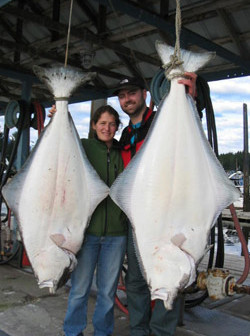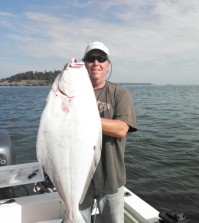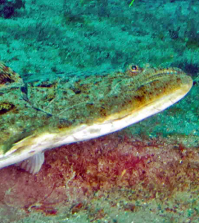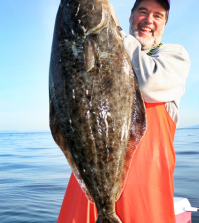What color for halibut?

“What color you using?”
It’s one of the most commonly asked questions in the world of fishing, asked by both freshwater and saltwater anglers, whether they’re fishing for black bullheads, black rockfish or black marlin, yellow perch or yellowfin tuna. It’s as though finding out what color lure that guy in the next boat just caught his last fish on is going to transform your fishing future. Well, maybe it will, but not likely.
And the great mystery of what color to use today haunts halibut anglers just as it haunts the rest of the fishing world. Even if we have our favorites, most of us pause to consider color every time we reach into our tackle box to select a lure.
But is lure color really all that important when you’re dropping that lure into 350 feet of water, in search of an eating machine big enough to fill a bathtub but with a brain not much larger than the end of your thumb? Let’s take a closer look.
We might want to start this discussion with a very quick (and over-simplified) science lesson. What we call “colors” correspond to the various wave lengths of light energy coming from an object. When we look at something of a particular color, we are actually seeing that one part of the color spectrum of natural light that is reflected back at us from the object. “Cool” colors like blue and green correspond to the shorter wave lengths at one end of the spectrum, while the “warm” colors of orange and red correspond with longer wave lengths at the other end.
We usually see color through the medium of air, but when we look at an object in the water—such as a halibut lure—things change. Water absorbs the radiant energy of light, sort of “filtering” it and causing a color change. Even if the water is absolutely clear, it gets darker as you get farther from the surface, because light rays are absorbed and scattered as they penetrate the water. The more suspended plankton, silt and other stuff there is in the water, the faster this light absorption and scattering occurs.
Since color is, in fact, light, it also disperses and weakens with water depth. The longer rays are absorbed fastest, which means red and orange turn to gray and then black in shallower water than other colors do. Green and blue, at the shortest end of the color spectrum, are absorbed slowest, meaning green and blue objects “maintain their color” at the greatest depths. White is a combination of all colors and all light wave lengths, and it is absorbed by the water very slowly and remains visible at the greatest depths.
Even though some fishermen still argue about it, the experts are in agreement that fish really do see in color, and in fact their ability to distinguish color seems to be pretty similar to that of humans. That doesn’t necessarily mean, though, that a halibut sees exactly what we see if it’s looking at a lure that one of us just dropped over the side. Scientists say that fish probably don’t see as wide a range of colors as we do, and their ability to differentiate colors likely varies from one species to another.
But one thing we do know for sure is that most of the halibut fishing we do down here near the southern end of the Pacific halibut’s range is in fairly deep—sometimes extremely deep—water, so whatever range of color they’re capable of seeing, that color is going to be greatly diminished or completely gone when it gets down to halibut eye-level. That bright red or hot orange jig you just dropped into the water will be black by the time it gets 50 feet below the surface, and even the cool greens and blues will do the same long before they hit bottom.
Remember, though, that white stays visible at greater depths than all other colors, so I usually play the odds and start out with white when I’m rummaging through my tackle box looking for the curl-tail grub or metal jig to tie on the end of my line first thing in the morning. In fact, take one look at my halibut gear and you’ll quickly noticed that most of the pipe jigs, leadheads, grub bodies and other lures in my halibut arsenal are white, off-white or a combination of white and some other color. When I’m fishing anywhere near home, I can expect to be fishing in 150 feet of water or more, depths where all other colors pretty much disappear, so why not go with something that stands at least some chance of being visible down there?
And the lure needn’t necessarily be all-white. Combinations of white or pearl along with contrasting colors can also work well for you. Many of my favorite metal jigs and plastic grub bodies are two-tone jobs of black/white, blue/white, green/white and red/white. Another way to achieve that contrasting-colors thing is to use lures of two different colors at the same time. When using a pipe jig or big leadhead as my main halibut lure, I’ll usually tie a short teaser leader about three feet up the line, and at the end of that teaser is a 7/0 or 8/0 hook with a five- or six-inch plastic grub threaded onto it. If the bottom lure is white, I’ll go with something darker on the teaser rig, and vice-versa.
So, if white is good for deep-water halibut, what about taking it a step or two further and adding luminescence or even artificial light to the mix? No doubt those enhancements should make a halibut lure more visible, so I’ve tried pretty much all of them, from hand-painting pipe jigs with luminescent paint to using “glow” lures, attaching light sticks of various sizes to lures, even using a friend’s invention that consisted of a jig that contained a battery-powered, flashing light. I still use these kinds of lures from time to time, but the truth is I’ve never really had a whole lot of success with any of them. Maybe it’s just me, but I can’t catch as many halibut with glow-in-the-dark lures as I can catch on the same lures in white or pearl.
Maybe your average halibut doesn’t need that added visibility of a glow lure to find its way to a potential meal. Any fish that can grow to 300 pounds or more must have long ago figured out a way to find food down there in the dark, so maybe they’re not desperate enough to strike at the first thing that jumps out in their field of view. If they’re not used to finding food that glows in the dark, glow lures may hold no special attraction. Taking that theory a step further, glowing “food” might even send a negative signal, perhaps even spooking them (if it’s possible to spook a halibut).
Then again, maybe I’m just struggling to find a good excuse for why glow lures don’t work all that well for me!
Although white tends to be my go-to color for halibut fishing deep water, I don’t do all of my halibut fishing on the deep-water halibut grounds of Washington Oregon and southern British Columbia. Many of my favorite northern halibut haunts—and a few down here that I don’t talk about very much—offer opportunities to find fish in water as shallow as 50 to 125 feet, and when fishing at those depths I have a lot of confidence in chrome and nickel finishes and the “natural” baitfish colors like green, black and gray. One of the biggest halibut I’ve ever hooked inhaled a chrome/green-back metal jig in 120 feet of water only seconds after the lure started bouncing along the bottom.
Which brings us to another important consideration when we think about what lure or what color lure to snap onto the end of a halibut line. Lure color and visibility are only two factors in determining whether a fish finds and decides to inhale your offering. Whenever you’re fishing artificials, lure movement is almost always going to be more important than lure color, so even if you’re using the “perfect” color for the situation, if the lure is just hanging lifelessly in the water, it’s not going to get bit very often. Movement not only enhances visibility, it also generates “sound” down there, and halibut use their sense of “hearing” (through their lateral line) to help them identify potential sources of food. Bouncing your lure along the bottom also creates sound that will draw halibut in for a closer look.
Halibut also depend on their sense of smell to locate food, so adding scent or natural bait to your lure also be as important or more important than your choice of lure color. Hang a strip of salmon belly or halibut skin on the hook or smear a little Smelly Jelly onto the lure and it will draw more attention than a “clean” lure, no matter the lure color.










